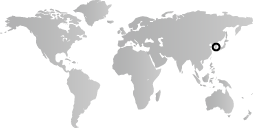Humans have inhabited the Korean peninsula from as early as the Pleistocene era, about 500,000 B.C. By the Neolithic period, beginning in about 7000 B.C., small settlements of hunters, fishers, and foragers are established near rivers or coastal areas. As in the case of other Neolithic cultures, pottery is one of the defining features of Korea’s Neolithic period. The earliest pottery—handcrafted clay vessels fired in open or semi-open pits at a relatively low temperature of approximately 700ºC—is used for preparing, serving, and storing food. The most typical Neolithic pottery in Korea is the so-called comb-pattern earthenware, which has a coniform or round base and is decorated with the distinctive incised or impressed linear patterns that give this ware its name.
Korea, 8000–2000 B.C.
Timeline
8000 B.C.
6500 B.C.
6500 B.C.
5000 B.C.
5000 B.C.
3500 B.C.
3500 B.C.
2000 B.C.
Overview
Key Events
-
ca. 7000 B.C.
By the Neolithic period, the inhabitants of the Korean peninsula subsist mainly on hunting, fishing, and gathering and live in small settlements of semi-subterranean circular or square dwellings located near rivers or coastal areas. Occupation sites have yielded a variety of artifacts, including pottery, chipped and polished stone tools, and bone needles and fishhooks. Objects identified as agricultural tools suggest the incipient stages of the transition from foraging to food production. The variety of pottery shapes and decorative techniques reflects the diversity of material cultures of the Neolithic period and points to contacts between populations living in different areas of the peninsula as well as those on the continental mainland to the north and west and the islands to the south that constitute modern Japan.
-
ca. 7000–5000 B.C.
The earliest known decorated pottery in Korea, handcrafted of sandy clay and fired in open or semi-open kilns at relatively low temperatures of about 700°C, is produced. Flat-bottomed vessels decorated with relief designs (yunggi-mun), excavated at Yangyang-gun, Osan-ri, in the central eastern province of Gangwon, are characteristic of eastern and southern coastal sites.
-
ca. 5000–1000 B.C.
Comb-pattern (bitsal muni) earthenwares, examples of which have been uncovered at Amsa-dong, a major dwelling site along the banks of the Han River east of present-day Seoul, are the most representative type of pottery from Korea’s Neolithic period. Occurring throughout the peninsula but especially concentrated in the western and southern coastal regions, these wide-mouthed storage and cooking vessels have a pointed or round base and are decorated with patterns of diagonal lines incised into the damp clay, perhaps with a comblike implement, before firing.
-
2333 B.C.
Traditional Korean sources present two different accounts of the origins of civilization on the peninsula. One credits this achievement to an indigenous demigod Dangun, whose legendary birth in 2333 B.C. is attributed to the union of a sky deity and bear-woman. The second account credits a Chinese noble and court minister, Jizi (Korean: Gija), who is believed to have emigrated to Korea with a large group of followers at the beginning of the Zhou Dynasty (1046–256 B.C.). The contrast between these two traditions reveals a tension that long conditions premodern Korean perceptions of their own culture: on the one hand, a proud awareness of cultural distinctiveness and, on the other, recognition of the extensive influence of Chinese civilization.
Citation
“Korea, 8000–2000 B.C.” In Heilbrunn Timeline of Art History. New York: The Metropolitan Museum of Art, 2000–. http://www.metmuseum.org/toah/ht/?period=02®ion=eak (October 2000)
